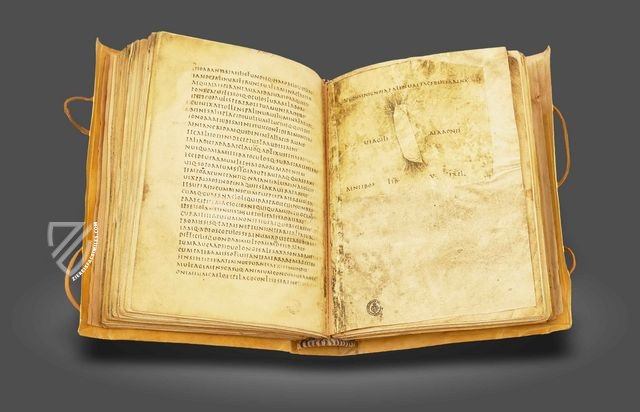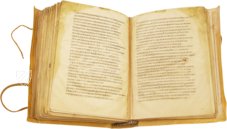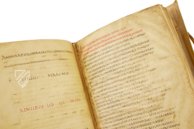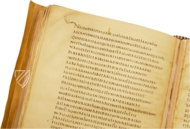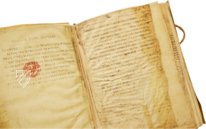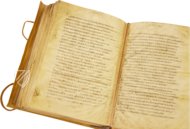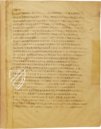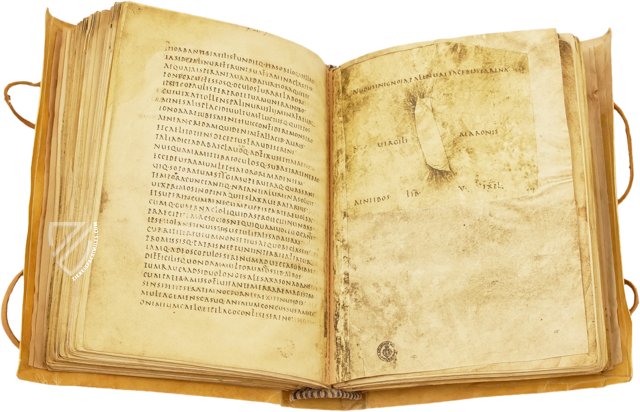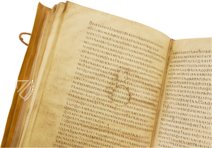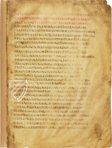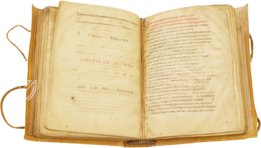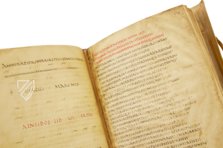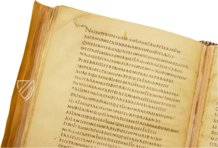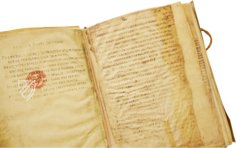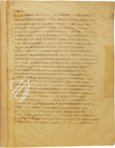Codex Laurentianus Mediceus
(1,000€ - 3,000€)
The Mediceus Laurentianus or Vergilius Mediceus is a famous manuscript written in Rome ca. 450 containing the most complete surviving text from antiquity of Virgil’s three major works: the Eclogues, the Georgics, and the Aeneid. Created with accuracy in mind for the purpose of studying the text rather than as a luxury manuscript, it is one of the most important textual sources concerning the works of Virgil. After passing through the hands of various important humanists including the Grand Duke of Tuscany Cosimo I de' Medici, the manuscript came to its current repository, the Biblioteca Medicea Laurenziana, ca. 1587.
Codex Laurentianus Mediceus
The individual manuscripts of the Biblioteca Medicea Laurenziana in Florence, which belonged to the historical basic holdings when the library was opened in 1571, are each referred to as Codex Laurentianus. The Codex Mediceus or Vergilius Mediceus is a Virgil (70-19 BC) manuscript written ca. 450 in rustic capitals preserved in the Laurentian Library, which contains the Georgics, Aeneid, and part of the Eclogues. A note at the end of the Eclogues records that the manuscript was corrected at Rome by Turcius Rufius Apronianus Asterius, who was consul in 494 during the reign of Theodoric the Great.
Form and Content of the Manuscript
Written in all capitals without punctuation or spaces between words, the manuscript contains the entirety of the Georgics and the Aeneid and only lacks the first five of the Eclogues and the beginning of the sixth up to verse 47. It is believed that the manuscript originally consisted of ca. 229 leaves, 220 of which are preserved, which measure 21.5 x 15 cm. The script is rather small in size making the manuscript appear less monumental than others, but this allows for 29 verses per page. It is a sophisticated text meant for private study rather than display, which is emphasized by the corrections made to the text for the sake of accuracy even at the expense of “marring” its appearance.
Coveted by Renaissance Humanists
The manuscript was recorded in Bobbio Abbey in the Emilia-Romagna region in 1467. In 1471, the manuscript found its way into the hands of the Italian humanist Julius Pomponius Laetus (1428-98) who made corrections of his own in red ink. It was first preserved in the Vatican Library, and later purchased by Cosimo I de' Medici (1519-74), the Grand Duke of Tuscany, from the heirs of Cardinal Rodolpho Pio da Carpi (1500-64), a prominent humanist and patron of the arts in his own right. Soon after 1587, it passed into the possession the Biblioteca Medicea Laurenziana, where the parchment codex is kept today. There is also a folio in the Vatican Library listed Cod. Vat. Lat. 3225, f.76.
Codicology
- Alternative Titles
- Scilicet P. Virgilii Maronis Bucolicorum pars, Georgicorum libri IV et Aeneidos libri XII
Virgilio mediceo
Il Codice Mediceo di Virgilio - Size / Format
- 442 pages / 22.0 × 15.0 cm
- Origin
- Italy
- Date
- Mid 5th century
- Epochs
- Style
- Genre
- Language
- Script
- Rustic capitals
- Content
- The Georgics, the Aeneid, and part of the Eclogues
- Artist / School
- Virgil (author)
- Previous Owners
- Bobbio Abbey
Julius Pomponius Laetus
Biblioteca Apostolica Vaticana
Cosimo I. de' Medici
Codex Laurentianus Mediceus
Note of the first corrector
At the end of the Tenth Eclogue, the last of the well-known collection of Virgil's pastoral poems known as the Eclogae or Bucolica, the Roman patrician Turcius Rufius Apronianus Asterius not only immortalized himself by commenting on the text, as is the case on many pages, but reveals to the reader that he revised the manuscript in 494 AD. The entry is dated April 21. At that time, the apparently highly educated man was consul under Theodoric the Great, who was not only king of the Ostrogoths from 493 to 526, but also ruler over all of Italy.

Codex Laurentianus Mediceus
Aeneidos Liber XII Explicit
The Aeneid is Virgil's epic poem about the mythological flight of Aeneas from captured Troy. Based on Homer's Iliad, but also inspired by the latter's Odyssey, Virgil describes Aeneas' numerous odysseys and encounters with goddesses and gods, mythological beasts and old acquaintances, until he finally arrives in Latium (central Italy), where he has to fight several battles before he can finally build a "new Troy" - Rome. The Aeneid thus tells a central founding myth of the Roman Empire.
Virgil's influential work is divided into twelve books, comprising a total of about 10,000 hexametric verses. In the Codex Laurentianus Mediceus, each book ends with a clearly recognizable explicit. Thus, this last page of the twelfth book closes with the words: VERGILI MARONIS AENEIDOS LIB XII EXPL FELICITER, distinguished from the rest of the clean script without punctuation or spaces between words by the airy placing of the individual words, thus visually realizing the caesura in content.

#1 Vergili Medicei simillimum publice phototypice impressum. Codex Laurentianus Mediceus
(1,000€ - 3,000€)
- Treatises / Secular Books
- Apocalypses / Beatus
- Astronomy / Astrology
- Bestiaries
- Bibles / Gospels
- Chronicles / History / Law
- Geography / Maps
- Saints' Lives
- Islam / Oriental
- Judaism / Hebrew
- Single Leaf Collections
- Leonardo da Vinci
- Literature / Poetry
- Liturgical Manuscripts
- Medicine / Botany / Alchemy
- Music
- Mythology / Prophecies
- Psalters
- Other Religious Books
- Games / Hunting
- Private Devotion Books
- Other Genres
- Afghanistan
- Armenia
- Austria
- Belgium
- Belize
- Bosnia and Herzegovina
- China
- Colombia
- Costa Rica
- Croatia
- Cyprus
- Czech Republic
- Denmark
- Egypt
- El Salvador
- Ethiopia
- France
- Germany
- Greece
- Guatemala
- Honduras
- Hungary
- India
- Iran
- Iraq
- Israel
- Italy
- Japan
- Jordan
- Kazakhstan
- Kyrgyzstan
- Lebanon
- Liechtenstein
- Luxembourg
- Mexico
- Morocco
- Netherlands
- Palestine
- Panama
- Peru
- Poland
- Portugal
- Romania
- Russia
- Serbia
- Spain
- Sri Lanka
- Sweden
- Switzerland
- Syria
- Tajikistan
- Turkey
- Turkmenistan
- Ukraine
- United Kingdom
- United States
- Uzbekistan
- Vatican City
- A. Oosthoek, van Holkema & Warendorf
- Aboca Museum
- Ajuntament de Valencia
- Akademie Verlag
- Akademische Druck- u. Verlagsanstalt (ADEVA)
- Aldo Ausilio Editore - Bottega d’Erasmo
- Alecto Historical Editions
- Alkuin Verlag
- Almqvist & Wiksell
- Amilcare Pizzi
- Andreas & Andreas Verlagsbuchhandlung
- Archa 90
- Archiv Verlag
- Archivi Edizioni
- Arnold Verlag
- ARS
- Ars Magna
- ArtCodex
- AyN Ediciones
- Azimuth Editions
- Badenia Verlag
- Bärenreiter-Verlag
- Belser Verlag
- Belser Verlag / WK Wertkontor
- Benziger Verlag
- Bernardinum Wydawnictwo
- BiblioGemma
- Biblioteca Apostolica Vaticana (Vaticanstadt, Vaticanstadt)
- Bibliotheca Palatina Faksimile Verlag
- Bibliotheca Rara
- Boydell & Brewer
- Bramante Edizioni
- Bredius Genootschap
- Brepols Publishers
- British Library
- C. Weckesser
- Caixa Catalunya
- Canesi
- CAPSA, Ars Scriptoria
- Caratzas Brothers, Publishers
- Carus Verlag
- Casamassima Libri
- Centrum Cartographie Verlag GmbH
- Chavane Verlag
- Christian Brandstätter Verlag
- Circulo Cientifico
- Club Bibliófilo Versol
- Club du Livre
- CM Editores
- Collegium Graphicum
- Collezione Apocrifa Da Vinci
- Comissão Nacional para as Comemorações dos Descobrimentos Portugueses
- Coron Verlag
- Corvina
- CTHS
- D. S. Brewer
- Damon
- De Agostini/UTET
- De Nederlandsche Boekhandel
- De Schutter
- Deuschle & Stemmle
- Deutscher Verlag für Kunstwissenschaft
- DIAMM
- Droz
- E. Schreiber Graphische Kunstanstalten
- Ediciones Boreal
- Ediciones Grial
- Ediclube
- Edições Inapa
- Edilan
- Editalia
- Edition Deuschle
- Edition Georg Popp
- Edition Leipzig
- Edition Libri Illustri
- Editiones Reales Sitios S. L.
- Éditions de l'Oiseau Lyre
- Editions Medicina Rara
- Editorial Casariego
- Editorial Mintzoa
- Editrice Antenore
- Editrice Velar
- Edizioni Edison
- Egeria, S.L.
- Eikon Editores
- Electa
- Emery Walker Limited
- Enciclopèdia Catalana
- Eos-Verlag
- Ephesus Publishing
- Ernst Battenberg
- Eugrammia Press
- Extraordinary Editions
- Fackelverlag
- Facsimila Art & Edition
- Facsimile Editions Ltd.
- Facsimilia Art & Edition Ebert KG
- Faksimile Verlag
- Feuermann Verlag
- Folger Shakespeare Library
- Franco Cosimo Panini Editore
- Friedrich Wittig Verlag
- Fundación Hullera Vasco-Leonesa
- G. Braziller
- Gabriele Mazzotta Editore
- Gebr. Mann Verlag
- Gesellschaft für graphische Industrie
- Getty Research Institute
- Giovanni Domenico de Rossi
- Giunti Editore
- Graffiti
- Grafica European Center of Fine Arts
- Guido Pressler
- Guillermo Blazquez
- Gustav Kiepenheuer
- H. N. Abrams
- Harrassowitz
- Harvard University Press
- Helikon
- Hendrickson Publishers
- Henning Oppermann
- Herder Verlag
- Hes & De Graaf Publishers
- Hoepli
- Holbein-Verlag
- Houghton Library
- Hugo Schmidt Verlag
- Idion Verlag
- Il Bulino, edizioni d'arte
- ILte
- Imago
- Insel Verlag
- Insel-Verlag Anton Kippenberger
- Instituto de Estudios Altoaragoneses
- Instituto Nacional de Antropología e Historia
- Istituto dell'Enciclopedia Italiana - Treccani
- Istituto Ellenico di Studi Bizantini e Postbizantini
- Istituto Geografico De Agostini
- Istituto Poligrafico e Zecca dello Stato
- Italarte Art Establishments
- Jan Thorbecke Verlag
- Johnson Reprint Corporation
- Josef Stocker
- Josef Stocker-Schmid
- Jugoslavija
- Karl W. Hiersemann
- Kasper Straube
- Kaydeda Ediciones
- Kindler Verlag / Coron Verlag
- Kodansha International Ltd.
- Konrad Kölbl Verlag
- Kurt Wolff Verlag
- La Liberia dello Stato
- La Linea Editrice
- La Meta Editore
- Lambert Schneider
- Landeskreditbank Baden-Württemberg
- Leo S. Olschki
- Les Incunables
- Liber Artis
- Library of Congress
- Libreria Musicale Italiana
- Lichtdruck
- Lito Immagine Editore
- Lumen Artis
- Lund Humphries
- M. Moleiro Editor
- Maison des Sciences de l'homme et de la société de Poitiers
- Manuscriptum
- Martinus Nijhoff
- Maruzen-Yushodo Co. Ltd.
- MASA
- Massada Publishers
- McGraw-Hill
- Metropolitan Museum of Art
- Militos
- Millennium Liber
- Müller & Schindler
- Nahar - Stavit
- Nahar and Steimatzky
- National Library of Wales
- Neri Pozza
- Nova Charta
- Oceanum Verlag
- Odeon
- Orbis Mediaevalis
- Orbis Pictus
- Österreichische Staatsdruckerei
- Oxford University Press
- Pageant Books
- Parzellers Buchverlag
- Patrimonio Ediciones
- Pattloch Verlag
- PIAF
- Pieper Verlag
- Plon-Nourrit et cie
- Poligrafiche Bolis
- Presses Universitaires de Strasbourg
- Prestel Verlag
- Princeton University Press
- Prisma Verlag
- Priuli & Verlucca, editori
- Pro Sport Verlag
- Propyläen Verlag
- Pytheas Books
- Quaternio Verlag Luzern
- Reales Sitios
- Recht-Verlag
- Reichert Verlag
- Reichsdruckerei
- Reprint Verlag
- Riehn & Reusch
- Roberto Vattori Editore
- Rosenkilde and Bagger
- Roxburghe Club
- Salerno Editrice
- Saltellus Press
- Sandoz
- Sarajevo Svjetlost
- Schöck ArtPrint Kft.
- Schulsinger Brothers
- Scolar Press
- Scrinium
- Scripta Maneant
- Scriptorium
- Shazar
- Siloé, arte y bibliofilia
- SISMEL - Edizioni del Galluzzo
- Sociedad Mexicana de Antropología
- Société des Bibliophiles & Iconophiles de Belgique
- Soncin Publishing
- Sorli Ediciones
- Stainer and Bell
- Studer
- Styria Verlag
- Sumptibus Pragopress
- Szegedi Tudomànyegyetem
- Taberna Libraria
- Tarshish Books
- Taschen
- Tempus Libri
- Testimonio Compañía Editorial
- Thames and Hudson
- The Clear Vue Publishing Partnership Limited
- The Facsimile Codex
- The Folio Society
- The Marquess of Normanby
- The Richard III and Yorkist History Trust
- Tip.Le.Co
- TouchArt
- TREC Publishing House
- TRI Publishing Co.
- Trident Editore
- Tuliba Collection
- Typis Regiae Officinae Polygraphicae
- Union Verlag Berlin
- Universidad de Granada
- University of California Press
- University of Chicago Press
- Urs Graf
- Vallecchi
- Van Wijnen
- VCH, Acta Humaniora
- VDI Verlag
- VEB Deutscher Verlag für Musik
- Verlag Anton Pustet / Andreas Verlag
- Verlag Bibliophile Drucke Josef Stocker
- Verlag der Münchner Drucke
- Verlag für Regionalgeschichte
- Verlag Styria
- Vicent Garcia Editores
- W. Turnowski Ltd.
- W. Turnowsky
- Waanders Printers
- Wiener Mechitharisten-Congregation (Wien, Österreich)
- Wissenschaftliche Buchgesellschaft
- Wissenschaftliche Verlagsgesellschaft
- Wydawnictwo Dolnoslaskie
- Xuntanza Editorial
- Zakład Narodowy
- Zollikofer AG

